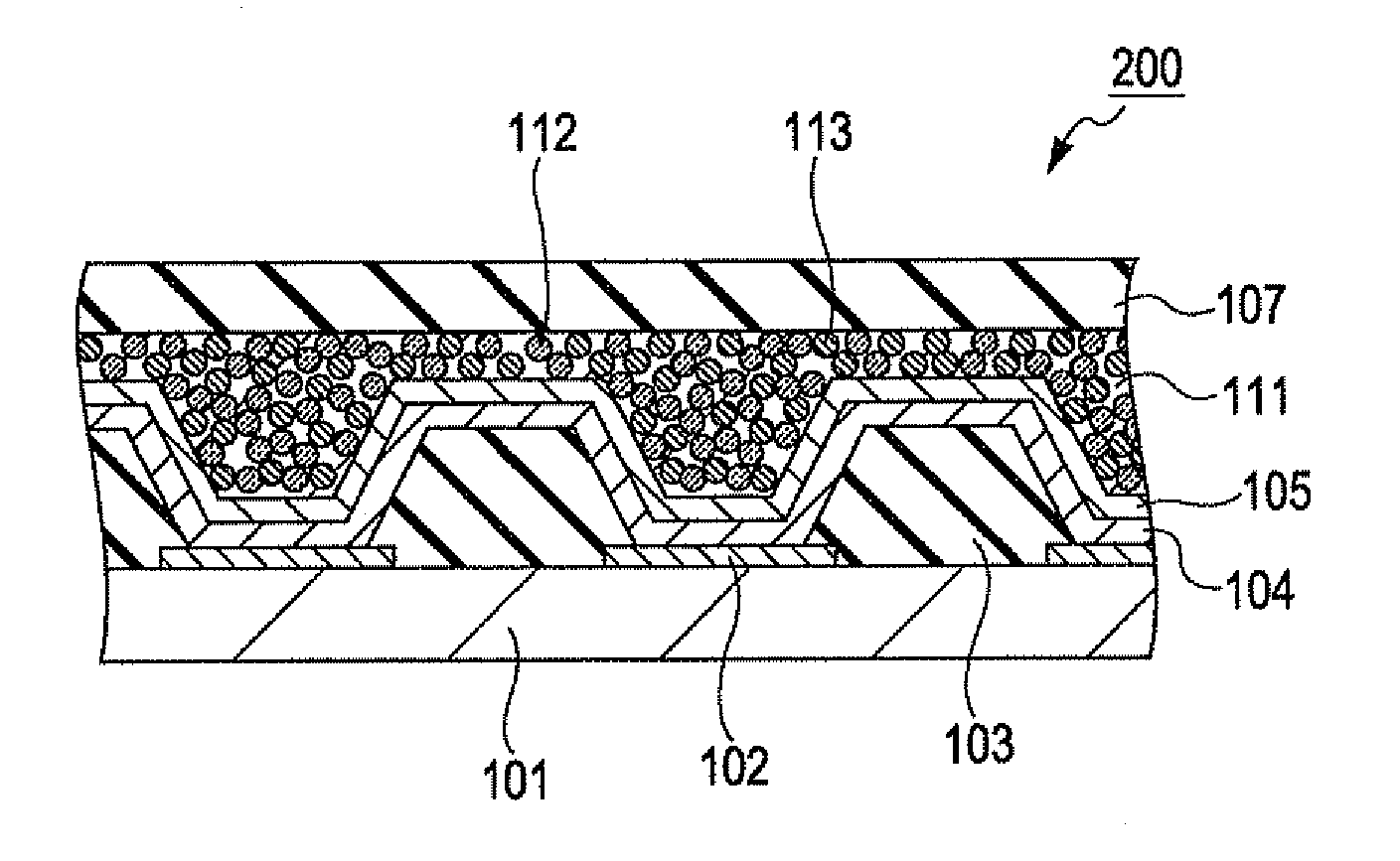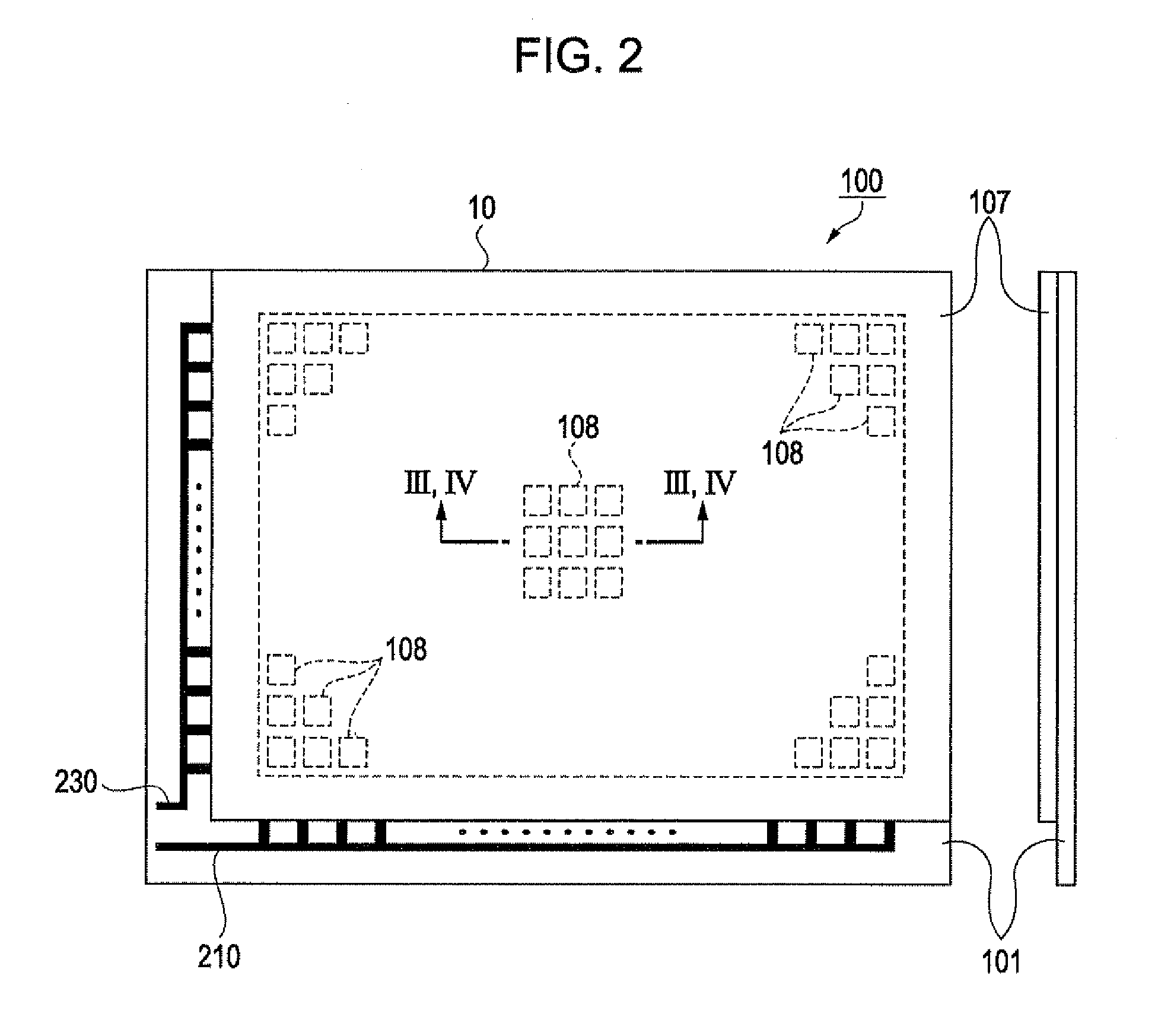Organic el lighting device and method of manufacturing the same
a lighting device and organic technology, applied in the direction of organic semiconductor devices, thermoelectric devices, solid-state devices, etc., can solve the problems of poor coating of organic functional layers in the taper portion of the barrier, uneven luminance in the plane due to voltage drop, and general poor light-emission unevenness, so as to facilitate the manufacture of organic el lighting devices and low cost
- Summary
- Abstract
- Description
- Claims
- Application Information
AI Technical Summary
Benefits of technology
Problems solved by technology
Method used
Image
Examples
first embodiment
[0054]FIG. 1 is an equivalent circuit schematic of an organic EL lighting device according to a first embodiment.
[0055]As shown in FIG. 1, an organic EL lighting device 100 of this embodiment has a lighting portion 10 and a power supply portion 50.
[0056]In the lighting portion 10, light-emitting portions (organic EL elements) 108 are formed in M columns×N rows (M and N are natural numbers equal to or larger than 1). Each of the plurality of light-emitting portions 108 is configured so that a first electrode 102, an organic functional layer 104 including a light-emitting layer, and a second electrode 105 are connected in series. In addition, a bleeder resistance R is connected to each light-emitting portion 108.
[0057]The power supply portion 50 supplies a high potential VH to the first electrode 102 via a first power wire 210, and supplies a low potential VL to the second electrode 105 via a second power wire 230. That is, the first electrode 102 functions as an anode and a second el...
second embodiment
[0089]FIG. 5 is a cross-sectional view showing a configuration of an organic EL lighting device according to a second embodiment of the invention.
[0090]As shown in FIG. 5, an organic EL lighting device 200 of the second embodiment has the same configuration as in the first embodiment, except that a conductive / light-scattering layer 111 is constituted by two kinds of fine particles. Accordingly, the same constituent elements will be denoted by the same reference symbols and the detailed description thereof will be omitted.
[0091]The conductive / light-scattering layer 111 of the second embodiment is formed of transparent fine particles 112 and conductive fine particles 113. As in the first embodiment, light-permeable fine particles such as SiO2, TiO2 or ITO are used as the transparent fine particles 112, and thus the light-scattering property can be given to the conductive / light-scattering layer 111.
[0092]Furthermore, since the conductive / light-scattering layer 111 includes the conducti...
third embodiment
[0095]FIG. 6 is a cross-sectional view showing a configuration of an organic EL lighting device according to a third embodiment of the invention.
[0096]As shown in FIG. 6, in an organic EL lighting device 300 of the third embodiment, an organic layer 114 is divided by barriers 115. The other constituent elements are the same as in the first and second embodiments, but the description will be given using the constituent elements in the first embodiment as an example. The organic functional layer 114 is not formed in a continuous manner but formed independently for each of the light-emitting portions 108. Accordingly, deterioration when a defect occurs can be suppressed in units of the light-emitting areas in which the organic functional layer 114 is formed.
[0097]In general, in the case of a light-emission defect which occurs in an intrusion route of moisture and oxygen, the moisture and oxygen intruding through this route spread via the organic functional layer, and thus the light-emi...
PUM
 Login to View More
Login to View More Abstract
Description
Claims
Application Information
 Login to View More
Login to View More - R&D
- Intellectual Property
- Life Sciences
- Materials
- Tech Scout
- Unparalleled Data Quality
- Higher Quality Content
- 60% Fewer Hallucinations
Browse by: Latest US Patents, China's latest patents, Technical Efficacy Thesaurus, Application Domain, Technology Topic, Popular Technical Reports.
© 2025 PatSnap. All rights reserved.Legal|Privacy policy|Modern Slavery Act Transparency Statement|Sitemap|About US| Contact US: help@patsnap.com



